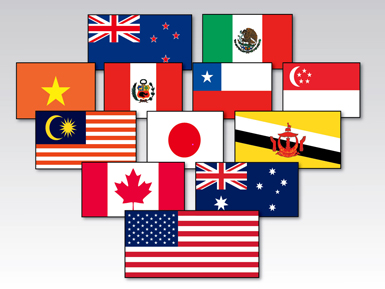Frontline: A “Transformative” Trade-Agreement Model for the U.S.
Q3 2014

The TPP is a regional Asia-Pacific trade agreement involving Australia, Brunei, Canada, Japan, Chile, Malaysia, Mexico, New Zealand, Peru, Singapore, Vietnam, and the United States. One of its goals is to significantly reduce, and ultimately eliminate, tariffs on most products and services traded between the agreeing countries. Another more aggressive goal is to eliminate a wide range of nontariff barriers on trade.
The U.S. already has free-trade agreements in force with 20 countries, so why is another needed? If a “transformative model” can be produced, it would not only put teeth into enforcement rules for protecting intellectual property, but also ensure open procurement practices are the norm for all countries so companies can freely and openly access foreign markets.
For example, localization barriers now threatening global trade would be lessened, or even eliminated. Gone would be the practice of one nation insisting that a firm from another nation locate a high-tech facility inside its borders or share intellectual property as a requirement of trade. An ideal TPP also would include a more transparent appeals process and rules liberalizing trade activity in services.
Why Should TPP Matter to Americans?
“The U.S. does $1.5 trillion in trade with these nations,” explains Stephen Ezell, senior analyst with the Information Technology and Innovation Foundation (ITIF) Washington, D.C. “This represents 40 percent of all our country’s trade, includes $690 billion in annual exports, and supports 15 million American jobs.”
Ezell says the agreement could help create 700,000 new jobs as early as 2015 — but only if a ‘high-level” TTP can be signed. “No TPP agreement would be preferable over a sub-standard document being created,” he notes.
In December 2010 President Obama formally notified Congress of America’s intention to enter the negotiations, which began in earnest in October 2010. This past July, Ottawa, Canada, hosted an informal round of TPP talks. Those negotiations “raised some concerns” for the U.S. in regard to competition agreements, says Ezell. For example, Malaysia and Vietnam requested an exception from any approved rules removing location barriers for digital trade. The United States has indicated it will not accept those terms. “From our point of view, the U.S. should not sign an agreement if it allows any country to be exempt from rules prohibiting that kind of activity,” he explains.
Another issue is the “Special 301 Report” published annually by the U.S. Trade Representative’s office. It assesses which nations are not doing an adequate job protecting foreign intellectual rights. “Sadly, five of our TPP partners are on that list: Canada, Mexico, Peru, Vietnam, and Chile,” says Ezell. “If TPP wants to be a high-standard, 21st- century trade agreement, it can’t include countries that remain on that list. They should get off it, and stay off it.”
Project Announcements
KBR Expands Davis County, Utah, Operations
04/15/2025
TL+CO Business Solutions Plans Seabrook, South Carolina, Production Operations
04/12/2025
Paragon Metal Fabricators Plans Falmouth, Kentucky, Manufacturing Operations
04/12/2025
Morris Packaging Plans Marion County, Kentucky, Production Operations
04/12/2025
Bailey Manufacturing Company Plans Laurinburg, North Carolina, Production Operations
04/11/2025
Palmetto Plastics Innovations Plans Hardeeville, South Carolina, Manufacturing Operations
04/11/2025
Most Read
-
Run a Job Task Analysis
Q4 2024
-
The Location Economics of Advanced Nuclear
Q1 2025
-
39th Annual Corporate & 21st Annual Consultants Surveys: What Business Leaders and Consultants Are Saying About Site Selection
Q1 2025
-
NEW NIMBYism: A Threat to The U.S. Economy
Q4 2024
-
Power, Policy, and Site Selection in 2025
Q1 2025
-
Designing Beyond the Assembly Line
Q1 2025
-
Why Workforce Readiness Can’t Wait
Q1 2025


